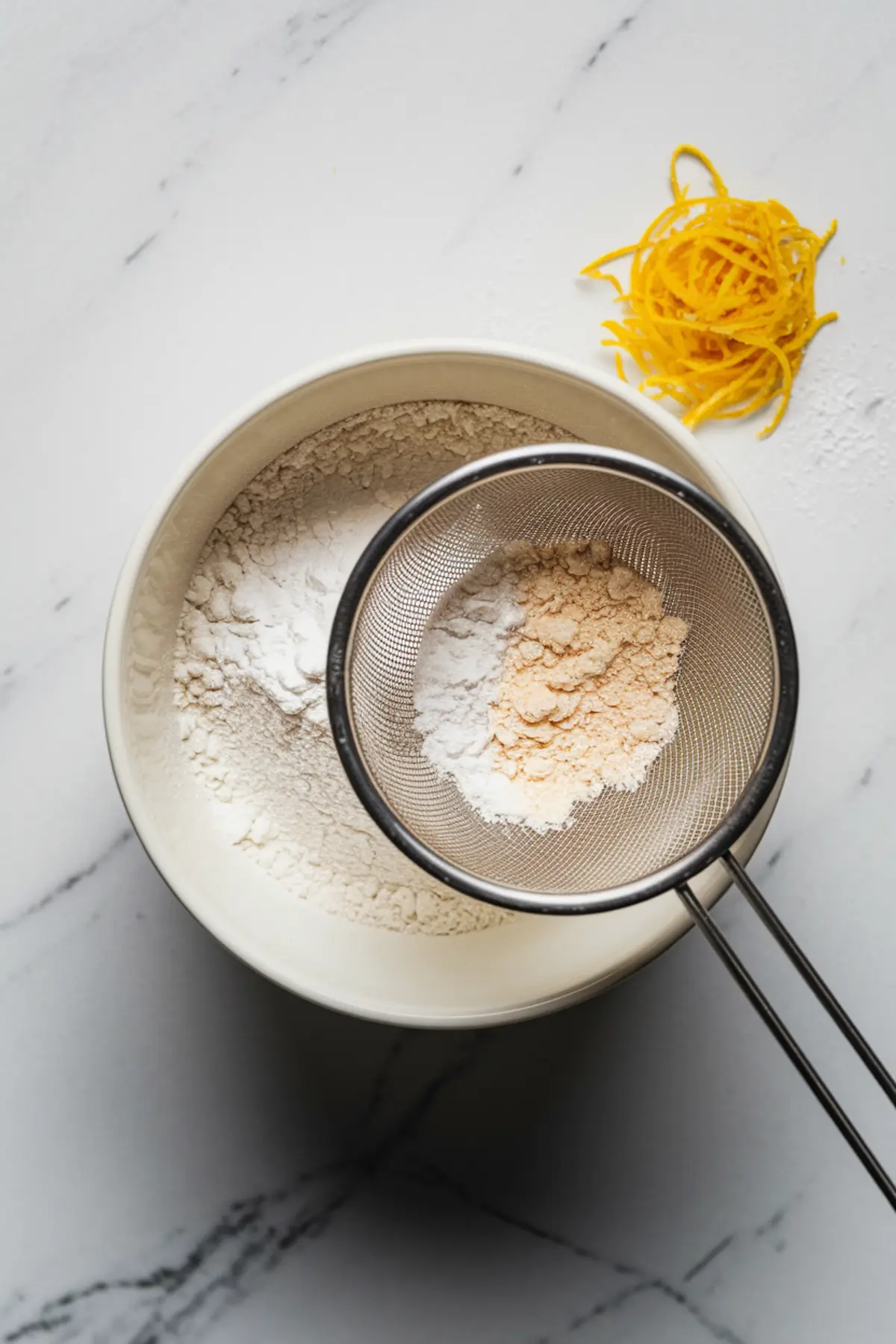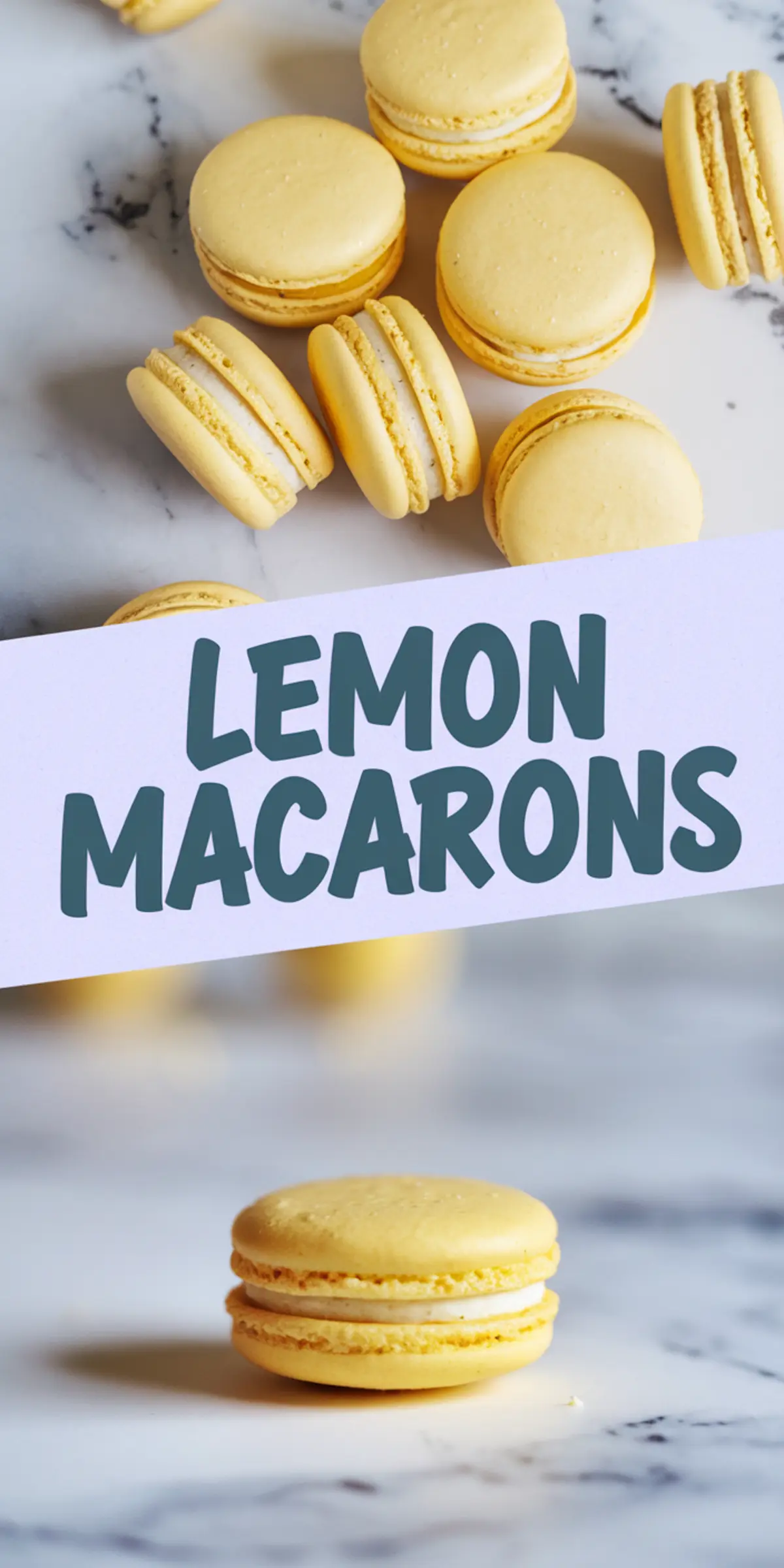I remember a time I sank my teeth into a lemon macaron at a small bakery. My taste buds danced, and I realized the magic behind that crisp shell. I tried my hand at recreating that moment in my own kitchen, and the result made me beam with pride.
My fascination started with the joy of experimenting in a home kitchen and blossomed after an aunt introduced me to her stand mixer during my teenage years. I learned to appreciate every step from whisking egg whites to piping batter with care. That curiosity never left me, and I still chase that vivid lemon fragrance every time I bake this recipe.
There’s a sense of reward that comes from cracking open a macaron shell to reveal a tangy buttercream. My friends keep asking for these bright bites, and their encouragement got me hooked on sharing the technique. This dessert turned into my personal project, and I keep refining it for maximum flavor.

Why Lemon Macarons Capture Attention
Baking these macarons stands out as a lively way to bring extra brightness to a dessert table. The shells have a texture you can’t resist, and that gentle crunch transitions into a cushiony interior. I also appreciate how the lemon element cuts through any sweetness with a light zing.
It’s easy to find good equipment to help you along, from a reliable oven thermometer to a capable hand mixer. I’ve seen many folks worry about the cost of bakeware, but specialized tools often last for years. A high-end stand mixer, for instance, makes quick work of stiff egg whites and might save your arm some effort.
Choosing fresh lemons adds another layer of freshness you can’t fake. I test different zest amounts to keep the citrus punch front and center. My best bakes happen when I let the shells rest correctly before baking, which helps achieve that signature “foot” at the base.
Tips To Achieve The Best Macaron Shells

A structured approach helps keep everything consistent, from sifting almond flour to whipping the meringue to firm peaks. My earlier batches suffered from cracks until I got serious about room temperature ingredients. An aged egg white can whip more reliably, especially if you let it sit a bit before mixing.
I recommend a parchment-lined tray for precise circles, but silicone mats also work. Tap your trays on the counter to pop air bubbles, which can ruin that smooth surface. A steady oven temperature around 300°F maintains even baking, so keep an oven thermometer on hand to confirm accuracy.
I monitor timing closely, because a few minutes too long and the texture shifts. Removing macarons at the right moment protects that delicate chew. Let them cool fully to avoid shells sticking to the parchment, which can break the integrity of each cookie.
Lemon Buttercream Joy

My love for a quality buttercream stems from the zing of real citrus juice. I sift my powdered sugar to guarantee a silky feel, and I whip softened butter until it’s creamy. Adding a splash of lemon juice brightens the frosting, while a bit of zest underscores that tangy vibe.
Sometimes I add a teaspoon of heavy cream if the mixture feels dense. That small adjustment helps the buttercream stay fluffy. The tart flavor mingles with the sweet macaron shell in a delightful way, which reminds me of that first bite I had all those years ago.
Pairing the shells with this buttercream captures the essence of a citrus dessert. A few friends skip the gel food coloring, but I enjoy that pop of cheerful yellow. It signals that lemon awaits inside.
A Personal Snapshot Of My Baking Process
I often set aside about two hours on weekends to make these macarons. My routine involves a moment of calm while the piped shells rest on the counter, giving me time to tidy or prepare other ingredients. After the timer sounds, I slide the tray in the oven and wait with eager eyes on my oven thermometer.
Those few minutes of baking bring a sense of excitement. I glance through the glass door hoping to spot those little ruffled feet forming. Once the shells cool, I swirl on lemon buttercream and press them together gently, feeling that soft cushion give way.
I’ve learned not to rush the final step of letting the macarons rest in the fridge. Patience pays off as flavors mingle overnight. That resting period transforms each bite into a balanced blend of sweet and sour.
Helpful Tools And High-Intent Cooking Supplies
A handy kitchen scale assists in precise measurements, which is essential for macaron success. Food processors can grind almond flour further, eliminating clumps that threaten a smooth batter. Many home cooks invest in a stand mixer with a whisk attachment, simplifying the process of reaching stiff peaks.
Kitchen gadgets can be long-term friends if you pick reliable brands. Some people also consider appliance warranties, giving them peace of mind if equipment fails. A well-equipped kitchen cuts down on frustration, letting you focus on the creativity of flavor development.
Don’t ignore basic kitchen safety, and think about a small liability plan if you run a home-based baking gig. Unexpected mishaps happen, so it helps to protect your gear. These details might feel like extras, but they keep your baking station ready for more sweet experiments.
Making The Most Of This Lemon Delight
It’s wise to store these macarons in an airtight container in the fridge for up to five days. Let them return to room temperature before enjoying so the shells stay soft enough to bite into. If you plan on freezing them, wrap each macaron securely, then place them in a freezer-safe container.
Guests tend to appreciate a dessert spread with variety. If you love other citrus treats, check out my Lemon Browniesfor a fudgy twist on classic bars. Another interesting option is Lemon Crumb Bars, which pairs well with afternoon coffee or tea.
I also adore Mini Lemon Tarts for brunch gatherings. Each one has a sunny color that stands out on any dessert table. Lemon has a unique power to brighten people’s day, and I love seeing the smiles.
Closing Thoughts On Baking And Sharing

I hope you give these zesty lemon macarons a try soon. Save this recipe to your favorite Pinterest board to keep it in easy reach. Share your results in the comments if you have questions or want to compare notes.
Baking has a way of connecting us through shared stories and tips, and I’m always eager to learn something new from fellow macaron fans. My process evolves with each batch, especially as I experiment with new fillings and citrus varieties. There’s a sense of satisfaction in crafting little treats that spark joy for those around me.
Your feedback makes this community stronger, so let’s keep the conversation going in the comment section. I’m happy to answer questions about technique or ingredients. Happy baking, and thank you for being a part of this sweet journey.
Zesty Lemon Macarons

A crisp, delicate shell with a smooth lemon buttercream filling creates a bright and tangy macaron. The balance of sweetness and citrus makes these a refreshing treat.
Ingredients
- FOR THE MACARON SHELLS:
- 100g almond flour (finely ground)
- 100g powdered sugar
- 75g egg whites (about 2 large egg whites, room temperature)
- 100g granulated sugar
- ¼ teaspoon cream of tartar
- ½ teaspoon lemon zest
- ½ teaspoon vanilla extract
- Yellow gel food coloring (optional)
- FOR THE LEMON BUTTERCREAM FILLING:
- 100g unsalted butter (softened)
- 200g powdered sugar
- 1 tablespoon lemon juice
- ½ teaspoon lemon zest
- 1 teaspoon heavy cream (if needed, for consistency)
Instructions
- PREPARE THE DRY INGREDIENTS: Sift the almond flour and powdered sugar into a large bowl. If any large almond pieces remain, discard them or blend them until fine. Stir in the lemon zest and set aside.
- MAKE THE MERINGUE: In a clean, grease-free bowl, whisk the egg whites on medium speed until foamy. Add the cream of tartar and continue whisking. Slowly add the granulated sugar while whipping, increasing the speed to high. Beat until stiff peaks form. Add the vanilla extract and a small amount of yellow gel food coloring if desired.
- FOLD THE BATTER (MACARONAGE): Add the sifted dry ingredients to the meringue in three batches, gently folding with a spatula. Fold until the batter flows like thick lava and creates ribbons when lifted with a spatula.
- PIPE THE MACARONS: Transfer the batter into a piping bag fitted with a round tip. Pipe small circles onto a parchment-lined baking sheet, spacing them about an inch apart. Tap the tray on the counter several times to remove air bubbles.
- REST THE MACARONS: Let the macarons sit at room temperature for 30–45 minutes, or until they form a dry skin. Preheat the oven to 300°F (150°C) while they rest.
- BAKE THE MACARONS: Bake for 14–16 minutes, rotating the tray halfway through. The macarons are done when they have firm feet and don’t jiggle when touched. Let them cool completely before removing them from the baking sheet.
- MAKE THE LEMON BUTTERCREAM: Beat the butter until creamy. Gradually add the powdered sugar, followed by the lemon juice and zest. If the buttercream is too thick, add 1 teaspoon of heavy cream to adjust consistency.
- ASSEMBLE THE MACARONS: Pipe a small amount of lemon buttercream onto half of the macaron shells. Sandwich them together with the remaining shells. Let the macarons mature in the fridge for at least 24 hours for the best flavor.
Notes
For the best texture, use finely ground almond flour and sift it well to remove any larger pieces. Aged egg whites (left at room temperature for a few hours) can improve meringue stability. Allowing the piped macarons to rest before baking is essential for forming a smooth shell. If the macarons crack or have hollow shells, try adjusting the oven temperature or using an oven thermometer for accuracy. Store macarons in an airtight container in the refrigerator for up to 5 days. Let them come to room temperature before serving for the best flavor and texture.
Nutrition Information
Yield
15Serving Size
1Amount Per Serving Calories 209Total Fat 9gSaturated Fat 4gTrans Fat 0gUnsaturated Fat 5gCholesterol 16mgSodium 11mgCarbohydrates 30gFiber 1gSugar 28gProtein 2g

